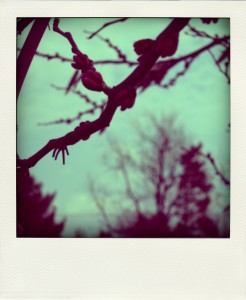
There’s a large tree right outside the window of the office where I now work. For the past three months, I’ve been settling into a new job, in a new town, in a new part of the country, experiencing new patterns of weather and rhythms of life for the first time, and in a way, the tree’s seasonal development seems to have kept pace with my own process of putting down new roots. Since January, I’ve watched the tree outside my office window turn from bare and covered with snow, to studded with red-tipped buds, to dripping with cascades of papery, yellow-brown flowers (which are no doubt a contributor to my allergy suffering, but are pretty nonetheless). Watching its seasonal transformations, the former would-be-biology-major in me can’t help but think of botany: the March rains that washed the inhibiting hormones from the tree’s growth tissues to signal that it was time for the eruption of flower buds, the pale, embryonic leaf shoots that now lie furled deep inside their own buds as they wait for their turn to emerge.
Spring, and thoughts like these, always remind me of one of my favorite poetry books of all time, Louise Glück’s The Wild Iris. The arc of The Wild Iris follows a garden and its grieving gardener through the cycle of the seasons, and I find its persona poems in the voices of various plants to be especially haunting. Take, for example, this excerpt from the titular poem, which opens the book:
At the end of my suffering
there was a door.Hear me out: that which you call death
I remember.Overhead, noises, branches of the pine shifting.
Then nothing. The weak sun
flickered over the dry surface.
Glück’s choices in crafting a voice for her iris seem to have been heavily informed by her knowledge of the plant’s seasonal life cycle: as perennials, irises die back at the end of each season and sprout again in the spring. Death and resurrection, again and again. Like an aging Persephone, Glück’s iris speaks with the shadow of the underworld fixed upon its lips. Its voice is dark and brittle, weary with the knowledge of its experience: for it, the earth is not a womb, but a grave; to break out is not a frantic exercise in escape, but rather, to pass temporarily from one world to the other, in the knowledge that at the end of its time of ecstatic flowering, it must return again to the darkness of the winter ground.
While today’s prompt doesn’t necessarily ask you to write in the voice of a plant as Glück does, I hope it will challenge you to consider the ways in which the processes of growth we can observe in things around us (like plants) can serve as markers of seasonal rhythms in our own lives.
Prompt: Write a poem that documents the growth cycle of some form of vegetation (like a plant, a lichen, a mushroom) as a way to record, reflect upon, problematize, or otherwise engage with a seasonal change or development in the speaker’s life.
